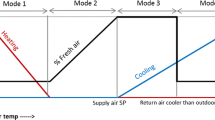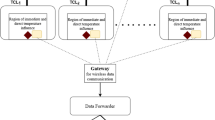Abstract
This paper aims to provide a summarized classification of fault detection and diagnosis (FDD) methods in Heating Ventilation and Air Conditioning (HVAC) systems by dividing them into knowledge-driven-based, data-driven and hybrid approaches, and then subdividing each category to more detailed categories. Considering the advantages and disadvantages of each method, it is concluded that knowledge-driven approaches require noticeable expertise, high number of input variables and consequently sensors to be installed, also having scalability issues. On the other hand, data-driven methods provide more precise results, while they require reliable labeled fault free and/or faulty data which is hard to access especially in real-world Building Automation System (BAS) data. Considering the disadvantages of knowledge-based and data-driven approaches and following a brief explanation of current studies based on hybrid methods, this paper highlights the necessity of hybrid FDD approach expansion in the future studies specifically in fault diagnosis.
Access this chapter
Tax calculation will be finalised at checkout
Purchases are for personal use only
Similar content being viewed by others
References
Mirnaghi, M.S., Haghighat, F.: Fault detection and diagnosis of large-scale HVAC systems in buildings using data-driven methods: A comprehensive review. Energy Build. 229, 110492 (2020)
Frank, S., et al.: A performance evaluation framework for building fault detection and diagnosis algorithms. Energy Build. 192, 84–92 (2019)
Yu, Y., et al.: A review of fault detection and diagnosis methodologies on air-handling units. Energy Build. 82, 550–562 (2014)
Wen, J., et al.: Building fault detection and diagnostics. In: Baillieul, J., Samad, T. (eds) Encyclopedia of Systems and Control. Springer, London (2020)
Torabi, N., et al.: A holistic sequential fault detection and diagnostics framework for multiple zone variable air volume air handling unit systems. Build. Serv. Eng. Res. Technol. 43(5), 605–625 (2022)
Bezyan, B., Zmeureanu, R.: Detection and diagnosis of dependent faults that trigger false symptoms of heating and mechanical ventilation systems using combined machine learning and rule-based techniques. Energies 15(5), 1691 (2022)
Katipamula, S., Brambley, M.R.: Methods for fault detection, diagnostics, and prognostics for building systems—a review, part I. HVAC&R Res. 11(1), 3–25 (2005)
Fan, C. et al.: Leveraging graph convolutional networks for semi-supervised fault diagnosis of HVAC systems in data-scarce contexts. Build. Simul., 1–19 (2023)
Chiosa, R., et al.: Towards a self-tuned data analytics-based process for an automatic context-aware detection and diagnosis of anomalies in building energy consumption timeseries. Energy Build. 270, 112302 (2022)
Kim, W., Katipamula, S.: A review of fault detection and diagnostics methods for building systems. Sci. Technol. Built Environ. 24(1), 3–21 (2018)
House, J.M., et al.: An expert rule set for fault detection in air-handling units. ASHRAE Trans. 107(Pt. 1), 858–871 (2001)
Yang, H., et al.: Sequential rule-based algorithms for temperature sensor fault detection in air handling units. Energy Convers. Manag. 49(8), 2291–2306 (2008)
Schein, J.: Results from Field Testing of Embedded Air Handling Unit and Variable Air Volume Box Fault Detection Tools. Gaithersburg, CA, USA: US Department of Commerce, National Institute of Standards and Technology (2006)
Wang, H., et al.: An online fault diagnosis tool of VAV terminals for building management and control systems. Autom. Constr. 22, 203–211 (2012)
Chen, Z., et al.: A review of data-driven fault detection and diagnostics for building HVAC systems. Appl. Energy 339, 121030 (2023)
Zhao, D., et al.: Artificial intelligence-based fault detection and diagnosis methods for building energy systems: advantages, challenges and the future. Renew. Sustain. Energy Rev. 109, 85–101 (2019)
Deshmukh, S., et al.: Fault detection in commercial building VAV AHU: a case study of an academic building. Energy Build. 201, 163–173 (2019)
Hassanpour, H., et al.: A hybrid modeling approach integrating first-principles knowledge with statistical methods for fault detection in HVAC systems. Comput. Chem. Eng. 142, 107022 (2020)
Chen, J., et al.: A review of computing-based automated fault detection and diagnosis of heating, ventilation and air conditioning systems. Renew. Sustain. Energy Rev. 161, 112395 (2022)
Zhao, Y., et al.: Diagnostic Bayesian networks for diagnosing air handling units faults–part I: faults in dampers, fans, filters and sensors. Appl. Therm. Eng. 111, 1272–1286 (2017)
Dey, D., Dong, B.: A probabilistic approach to diagnose faults of air handling units in buildings. Energy Build. 130, 177–187 (2016)
IEA EBC—Annex 81—Data-Driven Smart Buildings, https://annex81.iea-ebc.org/subtasks. Last Accessed 22 May 2023
Fan, C., et al.: Data-centric or algorithm-centric: exploiting the performance of transfer learning for improving building energy predictions in data-scarce context. Energy 240, 122775 (2022)
Nehasil, O., et al.: Versatile AHU fault detection—design, field validation and practical application. Energy Build. 237, 110781 (2021)
Acknowledgments
The work of Marco Savino Piscitelli was carried out within the Ministerial Decree no. 1062/2021 and received funding from the FSE REACT-EU—PON Ricerca e Innovazione 2014–2020.
Author information
Authors and Affiliations
Corresponding author
Editor information
Editors and Affiliations
Rights and permissions
Copyright information
© 2024 The Author(s), under exclusive license to Springer Nature Singapore Pte Ltd.
About this chapter
Cite this chapter
Piscitelli, M.S., Hooman, A., Rosato, A., Capozzoli, A. (2024). Overview on Fault Detection and Diagnosis Methods in Building HVAC Systems: Toward a Hybrid Approach. In: Littlewood, J.R., Jain, L., Howlett, R.J. (eds) Sustainability in Energy and Buildings 2023. Smart Innovation, Systems and Technologies, vol 378. Springer, Singapore. https://doi.org/10.1007/978-981-99-8501-2_61
Download citation
DOI: https://doi.org/10.1007/978-981-99-8501-2_61
Published:
Publisher Name: Springer, Singapore
Print ISBN: 978-981-99-8500-5
Online ISBN: 978-981-99-8501-2
eBook Packages: Intelligent Technologies and RoboticsIntelligent Technologies and Robotics (R0)




